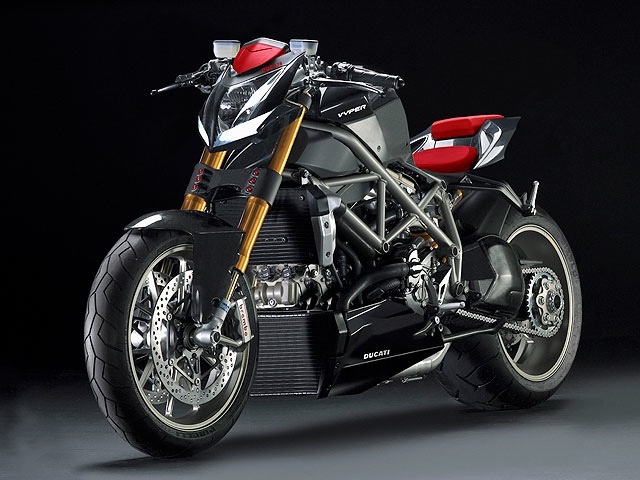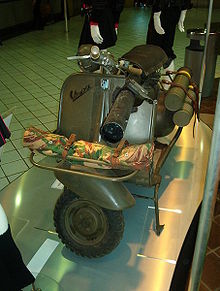Uploaded on May 5, 2010
Bloodhound SSC (officially capitalised BLOODHOUND SSC, BLOODHOUND supersonic car) is a car created by the international education initiative Bloodhound Project (BLOODHOUND Project) to attempt a 1,000 mph world land speed record.
The team aim to break the land speed record with the pencil-shaped car, powered by a jet engine and a rocket designed to reach 1,000 miles per hour (1,609 km/h) together with a Cosworth CA2010 Formula 1 V8 petrol engine auxiliary power unit.
It is being developed and built with the intention of breaking the land speed record by 33%, the largest ever margin.[1]
If £15 million of sponsorship funding is obtained the construction should be complete by the end of 2012 and the record attempts should take place in 2013 and 2014.[2]
BLOODHOUND SSC will be tested on the Hakskeen Pan, Northern Cape, South Africa where a track 20 km long, 500 m wide has been cleared by a local workforce, employed by the Northern Cape Government.
Logo of the project and image of the vehicle |
|
| Predecessor | ThrustSSC |
|---|---|
| Class | Land speed record vehicle |
| Engine | Rolls-Royce Eurojet EJ200 afterburning turbofan Falcon HTP hybrid rocket Cosworth CA2010 Formula 1 V8 race engine (APU) |
| Length | 13.5 m (44 ft) |
| Width | 1.9 m (6.2 ft) |
| Kerb weight | 6,422 kg (14,160 lb) (fuelled) |
Development
The project was announced on 23 October 2008 at the Science Museum in London by Lord Drayson - then Minister of Science in the UK's Department for Innovation, Universities and Skills - who in 2006 first proposed the project to Richard Noble and Andy Green (the two men, between them, have held the land speed record for 29 years).Richard Noble, engineer, adventurer, and former paint salesman,[3] reached 633 mph (1,019 km/h) driving turbojet-powered car named Thrust2 across the Nevada desert in 1983. In 1997, he headed the project to build the ThrustSSC, driven by Andy Green, an RAF pilot, at 763 mph (1,228 km/h), thereby breaking the sound barrier, a record first for a land vehicle (in compliance with Fédération Internationale de l'Automobile rules).
The task of driving the Bloodhound will fall to Wing Commander Green, who will lie feet-first in the Bloodhound SSC. As the car accelerates from 0-1,000 miles per hour (1,609 km/h) in 42 seconds, he will experience a force of approximately 2.5g (two-and-a-half times his body weight) and blood will rush to his head.
To slow the vehicle, Green will deploy air-brakes at 800 mph (1,300 km/h), and subsequently parachutes at 600 mph (970 km/h), with disc brakes used below 250 mph (400 km/h). As he decelerates, experiencing forces of up to 3g, blood will drain to his feet, with a risk of driver blackout. To condition his body for these intense g-forces, he will practice in a stunt aircraft, flying upside-down over the British countryside.
Design
The project is based in the former Maritime Heritage Centre on the Bristol harbourside, located next to Brunel's SS Great Britain. This building has been renamed the Bloodhound Technical Centre (BLOODHOUND Technical Centre).[citation needed]Aerodynamics
The College of Engineering at Swansea University has been heavily involved in the aerodynamic shape of the vehicle from the start. Professor Oubay Hassan, Professor Ken Morgan and their team have used Computational Fluid Dynamics (CFD) in order to provide an understanding of the aerodynamic characteristics of the proposed shape, at all speeds, including predicting the likely vertical, lateral and drag forces on the vehicle and its pitch and yaw stability.[4]This technology, originally developed for the aerospace industry, was validated for a land-going vehicle during the design of ThrustSSC. It was this involvement with the previous land speed record that prompted Richard Noble to approach Swansea in April 2007 to see if they could help with this latest challenge.
Swansea University's School of the Environment and Society was also enlisted to help determine a new test site for the record as the test site for the ThrustSSC record attempt has become unsuitable.[5]
Wheels
The four 36-inch (910 mm) diameter wheels will rotate at up to 10,200 rpm and will be forged from solid aluminium to resist the 50,000 g centrifugal forces.[6]Construction
Engineers produced the scale model which was exhibited at the launch,
and will integrate the engineering behind the car into its curriculum,
working with design team, led by Chief Engineer Mark Chapman. The car
will be built at a site in Bristol.[7]
The site will include an educational centre.[8] A full scale model was unveiled at the 2010 Farnborough International Airshow,[9] when it was announced that Hampson Industries
would begin to build the rear chassis section of the car in the first
quarter of 2011 and that a deal for the manufacture of the front of the
car was due.
Chief Engineer Mark Chapman says, "We aim to shake down the
vehicle on a runway in the UK at the beginning of 2013."
Education
The Bloodhound Project is first and foremost an education project designed to inspire future generations to take up careers in science, technology, engineering and mathematics (STEM) by showcasing these subjects in the most exciting way possible.The education program covers all phases (ages) of education from primary through to secondary and further education, plus Bloodhound@University. Any school, teacher, youth group or home educated family in the world can register their details on the BLOODHOUND SSC website and download the free curriculum resource materials.
Education institutions in the UK or South Africa can request a visit from a member of the Bloodhound education team or STEM Ambassador who will work alongside a teacher and deliver a presentation on the project.
There are also workshop activities for schools with a focus on learners aged between 9 and 14 years of age and the reasons why Hakskeenpan in the Northern Cape has been selected to run BLOODHOUND SSC.
The Bloodhound education program is also working with other STEM interventions and initiatives to ensure the Project reaches as many schools as possible. These include F1 in Schools (Bloodhound Class), the Smallpeice Trust, Primary Engineer, Science Made Simple and Young Engineers.
Uploaded on Oct 24, 2008
equinoxgraphics
Equinox Graphics is proud to present
the visualization of Bloodhound SSC, the trans-sonic rocket car aiming
to smash the current land speed record and raise it to a mind-bending
1000 mph (Mach 1.4).
The car is being designed and built in Britain, and Equinox Graphics has had the privilege of working in association with the design team to bring the car to life.
The minute-long viral video was produced on time and at High Definition (1920x1080, 25fps, full GI/radiosity) in just three weeks - including rendering time on our computer cluster.
The animation has proved extremely popular with the world's media, and has proved to be the ideal medium for engaging the public's imagination. It has so far been featured on BBC news (TV and online), and on stations as diverse as CNN and Al Jazeera.
More detail at www.bloodhoundssc.com and www.equinoxgraphics.net
The car is being designed and built in Britain, and Equinox Graphics has had the privilege of working in association with the design team to bring the car to life.
The minute-long viral video was produced on time and at High Definition (1920x1080, 25fps, full GI/radiosity) in just three weeks - including rendering time on our computer cluster.
The animation has proved extremely popular with the world's media, and has proved to be the ideal medium for engaging the public's imagination. It has so far been featured on BBC news (TV and online), and on stations as diverse as CNN and Al Jazeera.
More detail at www.bloodhoundssc.com and www.equinoxgraphics.net
Source: Wikipedia
TTFN
CYA Later Taters
Thanks for watching.
Donnie/ Sinbad the Sailor Man







